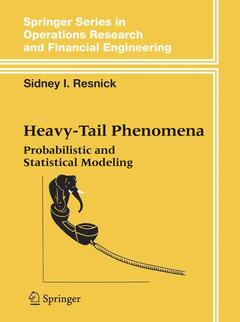Description
Heavy-Tail Phenomena, 2007
Probabilistic and Statistical Modeling
Springer Series in Operations Research and Financial Engineering Series
Author: Resnick Sidney I.
Language: English
Subject for Heavy-Tail Phenomena:
Approximative price 68.56 €
In Print (Delivery period: 15 days).
Add to cartPublication date: 11-2010
404 p. · Paperback
Publication date: 12-2006
404 p. · 17.8x23.5 cm · Hardback
Description
/li>Contents
/li>Comment
/li>
This comprehensive text gives an interesting and useful blend of the mathematical, probabilistic and statistical tools used in heavy-tail analysis. It is uniquely devoted to heavy-tails and emphasizes both probability modeling and statistical methods for fitting models.
Prerequisites for the reader include a prior course in stochastic processes and probability, some statistical background, some familiarity with time series analysis, and ability to use a statistics package. This work will serve second-year graduate students and researchers in the areas of applied mathematics, statistics, operations research, electrical engineering, and economics.




